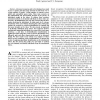Free Online Productivity Tools
i2Speak
i2Symbol
i2OCR
iTex2Img
iWeb2Print
iWeb2Shot
i2Type
iPdf2Split
iPdf2Merge
i2Bopomofo
i2Arabic
i2Style
i2Image
i2PDF
iLatex2Rtf
Sci2ools
ACCV
2009
Springer
2009
Springer
Person De-identification in Videos
Advances in cameras and web technology have made it easy to capture and share large amounts of video data over to a large number of people. A large number of cameras oversee public and semi-public spaces today. These raise concerns on the unintentional and unwarranted invasion of the privacy of individuals caught in the videos. To address these concerns, automated methods to de-identify individuals in these videos are necessary. De-identification does not aim at destroying all information involving the individuals. Its ideal goals are to obscure the identity of the actor without obscuring the action. This paper outlines the scenarios in which de-identification is required and the issues brought out by those. We also present an approach to de-identify individuals from videos. Our approach involves tracking and segmenting individuals in a conservative voxel space involving x, y and time. A de-identification transformation is applied per frame using these voxels to obscure the identity. F...
| Added | 08 Nov 2010 |
| Updated | 08 Nov 2010 |
| Type | Conference |
| Year | 2009 |
| Where | ACCV |
| Authors | Prachi Agrawal, P. J. Narayanan |
Comments (0)

